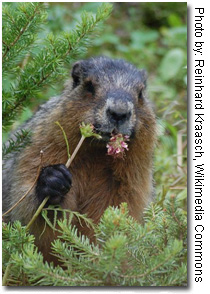Groundhog (aka Woodchuck)
(Marmota monax)
 Description and Range:
Description and Range:
Groundhogs are one of 14 species of marmots in the Squirrel family (Scuiridae). These large rodents can get up to 2 feet long and can weigh up to 14 pounds. Their body is covered with grizzled, grayish brown fur down its back. Groundhogs have short, powerful legs with dark brown feet equipped with heavy claws specialized for digging. Groundhogs also have a short, bushy tail and often sit on their haunches to feed.
Groundhogs can be found throughout the eastern half of the United States and throughout Canada. Groundhogs are also common throughout Maryland.
Habitat:
Groundhogs prefer to live along forest edges where timbered areas are bordered by open fields. They especially like fields used for agriculture. Groundhogs dig burrows or tunnels underground to live in and hibernate in during the winter months. These burrows provide homes for other animals like skunks, foxes, opossums and rabbits.
 Diet:
Diet:
Groundhogs are herbivores and often be found grazing on grass, leaves, flowers, clover, alfalfa, wheat and rye. Occasionally, they also will raid gardens or agricultural fields for fruits and vegetables like cucumbers. Groundhogs will also eat insects from time to time.
Reproduction:
Groundhogs generally breed when they reach two years of age, though some also breed their first year. Early March through April, Groundhogs mate and take up to 32 days for the young to develop. The male will stay in the den with the female until just before the young are born. Usually, litters consist of 2 to 6 blind, naked and helpless young which take 5 to 6 weeks to wean.
Behavior:
Groundhogs tend to be more solitary than other marmots. They will use their sharp claws to dig burrows for sleeping, nesting and hibernating. Generally, these burrows have 2 to 5 entrances to help escape from predators. Sometimes these burrows can be buried up to 5 feet down and can consist of as much as 45 feet of tunnel segments.
Beginning in late October and early November, groundhogs will hibernate. Their heartbeat can slow down to 4 or 5 beats per minute (bpm) from 80bpm! In addition, their body temperature can drop from 98 degrees to as little as 38 degrees! Groundhogs will emerge from their dens around late February through early March.
Sound:
Groundhogs are also known as whistlepigs, because when they are alarmed, they belt out a shrill whistle to warn others. Groundhogs will chatter teeth, hiss, squeal or growl when angry.
Management:
Groundhogs can cause damage to backyard plantings and building foundations. If you are having problems with groundhogs, then you should consult the nuisance wildlife hotline at 1-877-463-6497.